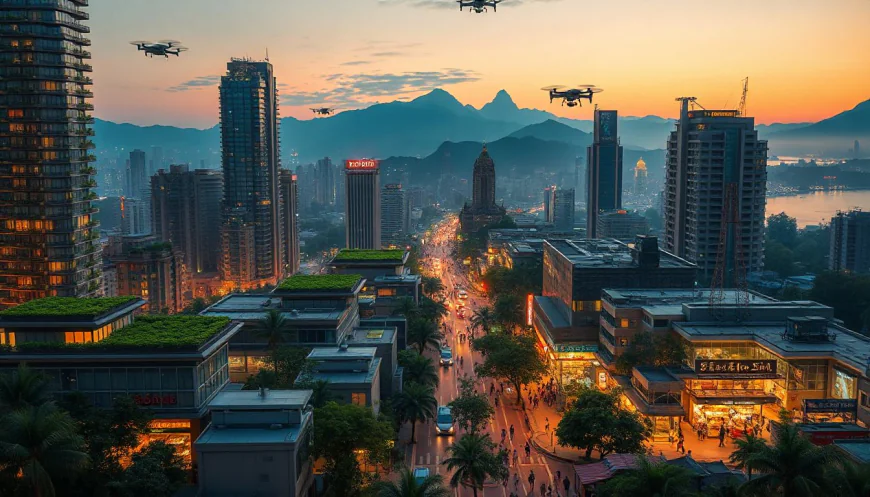Smart Cities in the Global South: Challenges and Breakthroughs
Smart city concepts have become a hot topic worldwide. They promise to make cities cleaner, safer, and more efficient. As urban centers grow fast around the globe, these ideas take on new importance. But in the Global South—regions like Africa, Latin America, and Asia—the journey is different. Rapid urbanization and new tech adoption bring both big hurdles and exciting breakthroughs. This article digs into the main challenges these cities face and the innovative solutions already making a difference.

The Need for Smart Cities in the Global South
Rapid Urbanization and Population Growth
Cities in the Global South are swelling faster than ever. For example, Africa’s urban population could triple by 2050. Latin America is seeing more people moving to cities for jobs and education. This growth puts massive pressure on roads, water systems, and homes. Cities need smarter ways to handle these changes to stay livable and safe.
Addressing Infrastructure Deficits
Many cities here struggle with traffic jams, water shortages, and poor waste collection. Roads are often overcrowded, and many neighborhoods lack reliable water service. Smart solutions can help fix these issues without massive new investments. For example, sensors can monitor water leaks and reduce waste. Cities also use apps to help residents report problems quickly.
Economic and Social Benefits
When smart tools work well, they boost the economy. People get better access to healthcare, education, and jobs. Smart systems can also increase safety by improving emergency services or reducing pollution. These advances help lift entire communities and improve quality of life.
Key Challenges in Implementing Smart City Initiatives
Financial Constraints and Funding Issues
Money is a big concern. Many cities don’t have the budget for large tech projects. Sometimes they rely on aid or private businesses for help. But big projects need careful planning to keep costs low. Small, smart steps can often lead to big results.
Technological Infrastructure and Digital Divide
Poor internet access hampers progress. Rural areas often lack good connectivity, leaving many residents out of the loop. Closing the digital gap is vital so everyone can benefit. Without it, smart city plans risk creating new divides instead of solving old problems.
Governance, Policy, and Regulatory Barriers
Many cities have patchy rules and unclear policies. This chaos can slow down projects or cause security concerns. Governments need clear laws for data privacy and citizen rights. Civic participation should be part of planning so solutions are fair and inclusive.
Environmental and Social Concerns
Smart cities can unintentionally cause hardship. Gentrification can push out poorer residents, and unequal access may widen gaps. Sustainable design helps avoid these problems. Green infrastructure and renewable energy make cities cleaner and more resilient.
Breakthroughs and Innovative Solutions in the Global South
Leveraging Low-Cost and Appropriate Technologies
Affordable tools are making big waves. Sensors that cost little can track traffic or pollution. Mobile phones already connect millions—so cities use them for services like transportation and health in places like Kenya and Brazil.
Public-Private Partnerships and International Collaboration
Partnerships between governments, businesses, and aid groups help fund and share knowledge. India’s Smart City Mission shows how collaborative efforts can bring innovation. International agencies also offer grants and advice to support local efforts.
Data-Driven Urban Management
IoT sensors gather real-time data on traffic, waste, and energy use. Cities analyze this info to make smarter decisions. Medellín in Colombia and Surabaya in Indonesia use data analytics to keep traffic flowing and improve public transport.
Community Engagement and Inclusivity
For smart cities to succeed, residents must participate. Regular feedback, digital literacy programs, and participatory apps empower communities. When locals help shape projects, solutions fit their needs better.
Green and Resilient Smart Urban Solutions
Sustainable ideas are taking hold. Many cities are adding solar panels and green roofs. They also build flood defenses and early warning systems to deal with climate dangers. These efforts help cities bounce back from storms and other disasters.
Future Outlook and Strategic Recommendations
To grow smart, cities in the Global South must focus on simple, affordable models. Encouraging local startups and innovation hubs can spark new ideas. Regional cooperation can share best practices and cut costs. Governments should also make clear policies for data use and citizen rights. All these steps create a smarter, fairer future.
Conclusion
Challenges like funding, technology gaps, and governance still stand in the way. Yet, breakthroughs in affordable tech, community input, and sustainable design show promise. Smart cities can transform urban life—making cities more liveable, green, and inclusive. For emerging economies, smart city projects aren’t just dreams—they’re a blueprint for growth. Stakeholders need to push for practical, fair, and eco-friendly solutions. The future of urban life depends on it.



 VARSHITHA
VARSHITHA